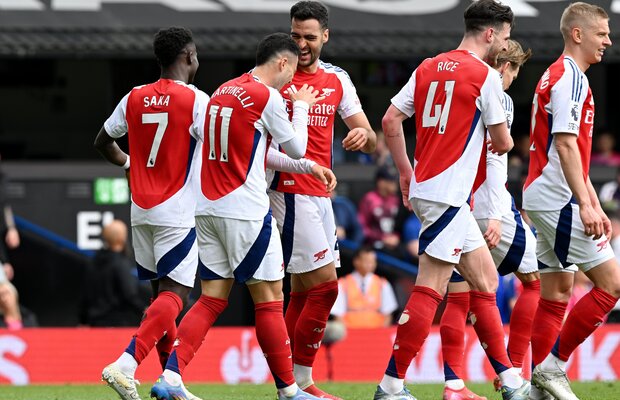- Jesus receives plaudits after ‘brilliant’ cameo vs Wolves
- Arsenal show interest in Real Madrid’s Victor Valdepeñas
- Predicted Arsenal line-up against Wolverhampton Wanderers
- Arsenal face pressure as rivals move for Yan Diomande
- Arsenal in fierce battle to sign Ousmane Diomande
- Arteta gives key injury updates ahead of Wolves clash
- Arsenal keep close watch on Dortmund goalkeeper Ramaj
- Pundit lauds Madueke after strong display vs Club Brugge
- Arsenal eye double swoop to sign Rodrygo Goes & Rafael Leao
- Arsenal showing ‘genuine interest’ in signing Adam Wharton
Why Arsenal’s Mid-Season Squad Rotation Could Define Their Title Bid
The Premier League title race never forgives fatigue. Arsenal look sharper and deeper than before, but now face a brutal run from autumn into spring. Mikel Arteta knows this stretch can define the season. His rotation calls could decide whether they lift the trophy or fall short.
Arsenal play every three or four days in the league, Europe, and cups. Recovery time is scarce, and even top pros start to feel the grind. For those tracking how workload affects odds and team form, welcome bonus betting sites often highlight how fixture congestion shifts betting lines and confidence in a team – and Arsenal’s current rhythm shows exactly that.
Heavy Workload and Risk Zones
Bukayo Saka, Martin Ødegaard, and William Saliba remain the heartbeat of this Arsenal side. Yet they have already logged more than 1,000 minutes each by late October. It’s an early warning sign. Last season, Arsenal’s dip began when fatigue hit key starters. The medical staff now monitor sprint counts, recovery scores, and soft-tissue strain to prevent a repeat.
Rotation helps, but it’s not just about swapping players randomly. It’s a calculated system. Arteta uses performance data to decide who rests and who pushes through. When Saka feels muscle tightness, for instance, Eberechi Eze or Gabriel Martinelli might cover the wide roles, keeping Arsenal’s pressing shape intact.
What Arsenal Can Control
Managing minutes effectively could keep Arsenal competitive through spring. The technical team aims to:
- Limit each core player to around 70% of total possible minutes before April.
- Use 18-20 players regularly, avoiding overuse of the same eleven.
- Introduce early substitutions in games where the score allows rest periods.
Simple on paper, hard in practice. Every match matters, and dropping points can invite pressure.
Tactical Adjustments Without Losing Identity
Arteta rarely strays from a 4-3-3 structure. The key lies in subtle tweaks. Oleksandr Zinchenko or Jurrien Timber invert from full-back to control midfield. Martin Zubimendi shields the defence while Ødegaard drives tempo and creativity. The system demands high energy, so physical drop-offs can quickly disrupt flow.
Rotation now looks more strategic. Christian Nørgaard adds bite when Arteta expects a scrappy midfield battle. Against possession-heavy sides, he might rest Havertz or Eze to maintain balance. In cup matches, even the goalkeeper changes: Kepa or Ramsdale rotate based on match type and fitness metrics.
The Core Rotation Map
Recent data shows Arsenal rotate between two and five players per match depending on competition level. The typical structure involves:
- Defensive swaps – especially in cup ties or versus lower-table opponents.
- Midfield reshuffles – alternating control players with more physical ones.
- Attacking refresh – ensuring at least one winger or striker sits out every second or third game.
This keeps intensity high and muscles fresh, though too much rotation risks disrupting chemistry.
Balancing Freshness and Cohesion
Rotation offers benefits, but it carries its own traps. Cohesion can slip when combinations constantly change. Ødegaard’s link with Saka, for example, thrives on rhythm. Remove one too often, and patterns weaken. Arteta seems aware of this: he rotates clusters, not individuals, so partnerships evolve together.
Physically, Arsenal appear stronger this season. The training focus shifted toward load management, with tailored recovery days replacing uniform schedules. Sleep tracking and nutrition reports feed into player availability charts before each matchday. It sounds scientific because it is – modern football margins live in the details.
When Rotation Works Best
Based on past trends, Arsenal perform better when Arteta plans rotation blocks around fixture groups rather than reacting week by week. In December, for example, when fixtures pile up, planned alternation allows players to peak for key rivals like Manchester City or Liverpool instead of burning out earlier.
Key moments to rotate smartly include:
- Cup ties against lower-league opposition.
- Home games versus bottom-half Premier League sides.
- Group-stage European fixtures when qualification looks secure.
Each rotation window buys freshness for later months, the stage where most title races tighten.
Why This Period Feels Decisive
Arsenal learned last season that elite form in autumn means little if legs fade by April. The coming mid-season stretch will define whether this team can handle both domestic and European fronts. With depth across all lines, they finally possess the tools to rotate properly. But timing substitutions, trusting backups, keeping rhythm will decide their fate.
Arteta doesn’t hide from the challenge. “The team that stays sharp the longest usually wins,” he said recently. For Arsenal, that sharpness depends on smart rotation, not heroic endurance. It’s a test of planning, trust, and timing – the quiet work that often determines who ends the season holding silverware.





